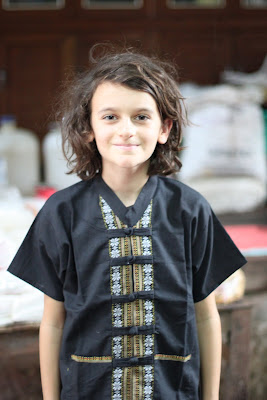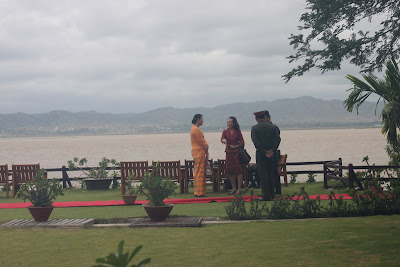 |
| Grinding peanuts for peanut oil - Big business in Burma! |
 |
| The nuts |
 |
| Where the nuts come from -- underground! |
 |
| Riding the ox grinder |
 |
| Where the peanut oil drips out, after the nuts are ground |
 |
| The wooden grinder, with the peanut remains |
 |
| Feeding the peanut remains to the ox, post-peanut grinding |
 |
| A natural cowgirl |
 |
| Parts of palm trees |
 |
| The palm fruit |
 |
| The palm sap collector |
 |
| Better to pray to have Buddha on your side, Just in case |



 |
| The royal tasting of the palm |
 |
| The palm sap |
 |
| One of the many forms palm takes -- this one, a highly distilled form |
 |
| The distillery |
 |
| The fermenting pot, buried into the ground |
 |
| The distillery chef |
 |
| Pure palm alcohol |
 |
| Ox food - the palm fruit remains |
 |
| The tree trunk used for cosmetic purposes on all Burmese women |
 | ||
| Wet then rub the wood to make the "Thanaka," the cosmetic Burmese women wear. The tree has to be 35 years old, at least, to be worthy of Thanaka-making |
 | |
| Thanaka application - Burmese feel like it adds both beauty and protects their skin from the sun, so they put it on the kids to protect their faces from the sun too. |

 |
| Thanaka-covered |
 |
| Thanaka in the shape of a leaf. Some kids wear Thanaka in the shape of Mickey Mouse. |
 |
| A temple at the top of monkey mountain. The locals and temple-dwellers treat the monkeys there with spiritual reverence, thinking the monkeys are beloved by Buddha and the temple gods there |
 |
| Climbing up the many steps to the top, Ken and a local guy connect, in typically friendly Burmese fashion. The Burmese man wears a "Longyi" which is like a sarong tucked in with a knot up top. |
 |
| Awww, baby! Climbing up to mama |
 |
| Every temple, often called stupa, have gold-covered domes, and, really, gold-covered everything. |
 |
| The windy top |
 |
| Ring the bell three times for good luck |
 |
| He is a "nat", or a human who became a saint when he died. If you leave money on him, it's assumed you'll get money too. |
 |
| Top of the temple, after lots of climbing |
 |
| My brave warriors, ready to fight the monkeys with their umbrellas |
 | |||||
| The monkeys had come close to us, looking ready to attack, or maybe just eager for food. | So | the boys fended them off. |
 |
| Another nat |
 |
| Turns out Abraham was shrieking because he saw a monkey steal Ken's shoe from outside the nat worshiping room. |
 |
| Ken thought the shoe stealing was funny |
 |
| We had no idea how you get a shoe back from a monkey. But, this Burmese saleswoman lured the monkey with a banana and stole Ken's shoe back from the monkey. |
 |
| Abraham was completely distraught over the monkey taking Ken's shoe. |
 |
| Boom took a while to recover, even after we recovered the shoe. |
 |
| The offending monkey, keeping an eye out for another unsuspecting pair of shoes. |
 |
| The Burmese military joined the Thai air force, giving the Thai military a "Best of Burma" tour. |
 |
| The Thai general of honor sat by himself for breakfast, with his wife, that is. And many would come by and bow to him. |
 |
| Alice's notes written on "Nyaungoo Market" in Bagan. The produce was out of this world - I've never seen ones like this before. |
 |
| Bamboo shoots |
 |
| They call these medicated eggs - some sort of fermenting process of eggs so they don't go rotten. They got the idea from China. That's some sort of lyme and chaff or sawdust, I think. |
 |
| The betelnut is wrapped in a leaf like a burrito with lime paste and tobacco wiped on the leaf. Betelnut-for-girls substitutes something sweet for the tobacco. |
 |
| Jasmine to perfume the women's hair. Unlike China, women in Burma take beautiful, cosmetic care of their bodies, skin, and clothing. |
 |
| The Jasmine petals. |
 |
| How they sew the jasmine onto a long thread. |
 |
| Bags of the other Burmese national addiction - RICE -- at the market |
 |
| The eskimos can identify 300 types of snowflakes, and the Burmese can identify equally many types of rice. It all looks like just plain old rice to us. |
 |
| Yes, deep in the heart of Burma is a Brooklyn t-shirt. I've never seen Brooklyn looking so cutesy-pie. |
 |
| Owner of an expansive clothing stall, housed with many women sewing and selling. |
 |
| Our guide with Alice is her matching Burmese women's wear. Shiny and pink, the way Alice likes it. |
 |
| Boom wearing Burmese men's wear |
 |
| Grif too |
 |
| Me too! I had them make me 4 shirts, and a skirt, and they tailored them right on the spot. |
 |
| We also visited the Burma Lacquerware Factory, where it turns out lacquerware (bowls, etc.) all start with a bamboo base, making them light as a feather. |
 |
| Lacquer, from a lacquer tree, which has sap so poisonous that even its vapours can cause a serious rash. |
 |
| Colors ground down from various natural elements. |
 |
| The men are bred to be the real craftsmen, making the design carved into the side of the laquerware. The women do painstaking digging, based on the men's design. |
 |
| The designs get pretty elaborate. |
 |
| Boom sat in awe, practically in prayer, watching the men use speedy, loud machines to whittle away the lacquerware. |
 |
| You can't see the Bagan temples at night, but you can see marionettes! |
 |
| The marionette musicians for the marionette theater dinner. |
 |
| We collected a huge number of marionettes in Southeast Asia and it was good to see them wielded with skill. |





